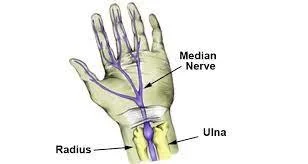How does Carpal Tunnel Syndrome Occur and What Can be Done to Help?
In this article, I’m going to explain what exactly carpal tunnel syndrome is, how it happens over a long period of time, and various treatments for it we can offer in the office.
So! Let's have ourselves a little anatomy lesson here. Carpal Tunnel Syndrome is an inflammation of the Median Nerve as it passes through the wrist. The Median Nerve supplies your thumb, pointer finger, middle finger, and the thumb side of your ring finger.
The Median Nerve as it passes through the wrist.
Oftentimes the inflammation from Carpal Tunnel Syndrome is presented with the following feelings in the hand:
Numbness in the affected fingers
Tingling in the hand/fingers
Shooting pain in the wrist that radiates to either the finger or up the forearm when the hand is squeezed
An almost “static” like feeling of sensation
The feeling of warm water running down your hand
A sharp pain in the wrist at rest
The most common long term cause of this condition is a repetitive use injury in the hand/wrist. Some common forms of repetitive movements that can cause this/make it worse are:
A perfect example of how your wrists shouldn’t be when typing on the computer.
Typing on a computer
Knitting/Crocheting
Doing too many massages in a week
Typing on a phone
Pretty much anything that utilizes a lot of very nuanced hand/finger movements
One of the most effective treatment protocols that I’ve used, and actually helped to publish a research study on, is a multifold plan utilizing many approaches to the session.
I usually like to start with some ice massage directly on the forearm, wrist, and hand to help reduce active inflammation. From there, I will move straight into a Myofascial Release approach to help restore proper movement to the tissues that have issues, oftentimes moving into something like Active Release Therapy, Gua Sha, and/or Cupping. One of my favorite ways is to end the treatment with some form of circulatory work followed by Kinesiology Tape, like Swedish Massage, to really get some good blood flow in the area so it can heal faster.
Whoa. Those were a lot of words that don’t make much sense. Here, let me break them down for you.
Myofascial Release - it feels almost like someone is doing yoga directly to a muscle or muscular system. Oftentimes, no massage oil or lotion is used at all so there is some drag. It is mostly a very subtle approach that causes a very gentle release in the tissue.
Active Release Therapy - This one is one of my favorites! It really requires us to think about what we are addressing under the skin. The easiest way to explain this modality is, the therapist will gently pin down a muscle, usually over a trigger point, and have the client perform the muscle’s action and its opposite action. It can feel intense at times but shouldn't cross over into pain. If it does, let them know!
Gua Sha - Gua Sha is a treatment that has many deviations from it’s original approach in ancient China. A smooth edged stone tool is used in superficial quick strokes to stimulate Chi, bloodflow, and muscular release.
Cupping - Another fantastic treatment from ancient China. The modern approach to cupping utilizes some form of suction with either a silicone, plastic, or glass cup to pull some of the soft tissue up into the tool to release the connective tissue in a way it isn’t necessarily used to being addressed. Oftentimes, I won’t allow the cups to be static in one space, I will move them around to get more of a release. (This modality often leaves some kind of mark on the skin that can last for up to two weeks, I always like to say it looks like you got in a fight with an octopus and won).
Swedish Massage - When people talk about massage, this is the modality that comes to most people’s minds. Really slow and superficial strokes that are sssuuupppeerrrr soothing to the body, mind, and spirit. If you want an example of some awesome Swedish Massage here is a time lapse I did of the Swedish approach to someone’s forearm who was having CTS like symptoms.
Kinesiology Tape - You know those super bright strips of tape you see on people who do a lot of sports? That’s KT tape! It’s a really cool tool that’s been around since the early 90’s where you use a specific kind of tape, that has the same elasticity as the skin, to slightly warp the fascial structure to provide support to injured tissue.
That is a general breakdown of how I approach CTS. Mind you, everyone's body is different and responds to these protocols differently so, a fair amount of customization would also happen depending on each person's bodies and needs.
Want to experience it first hand? Book an appointment to find out how well this approach works!

